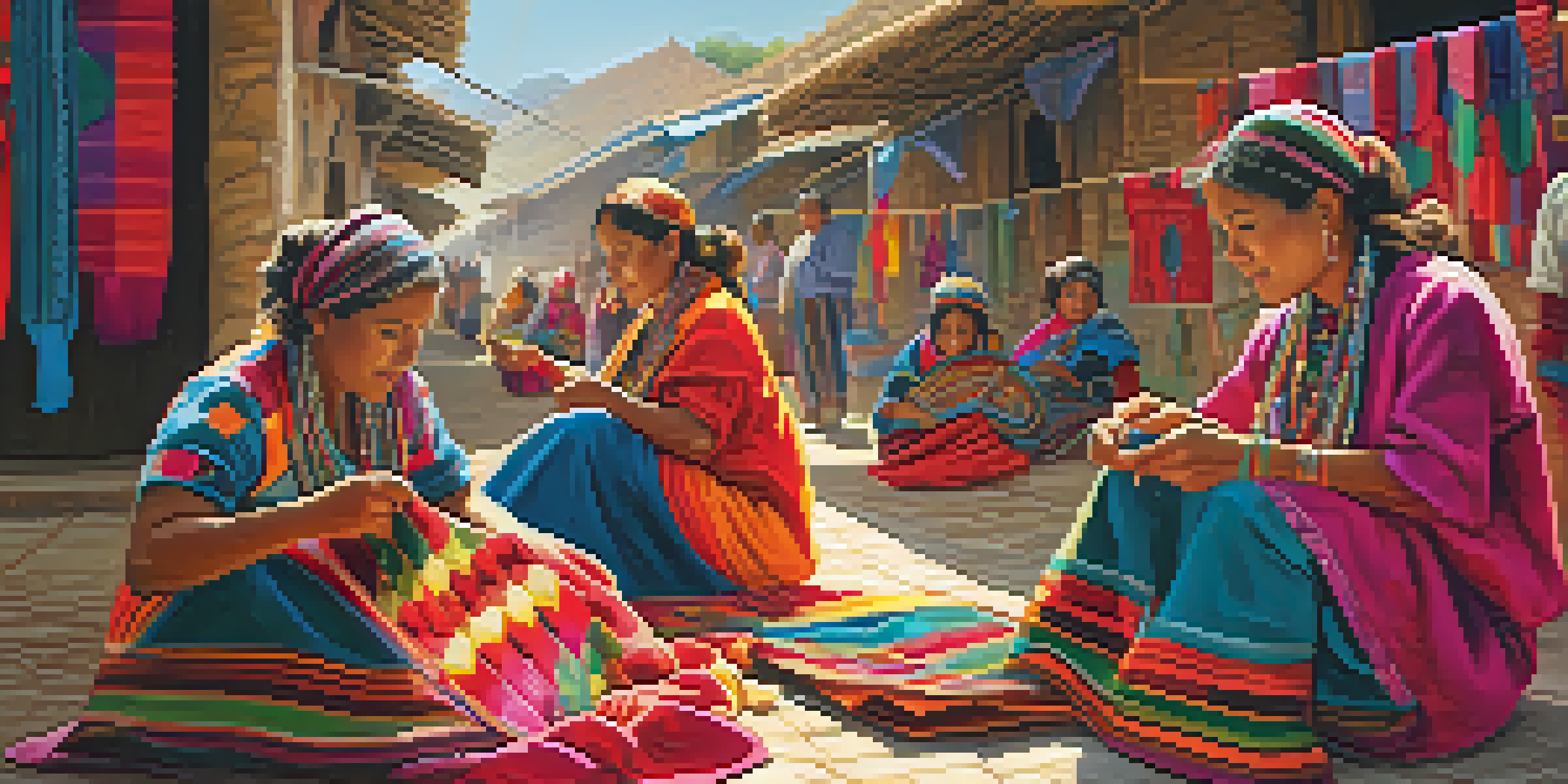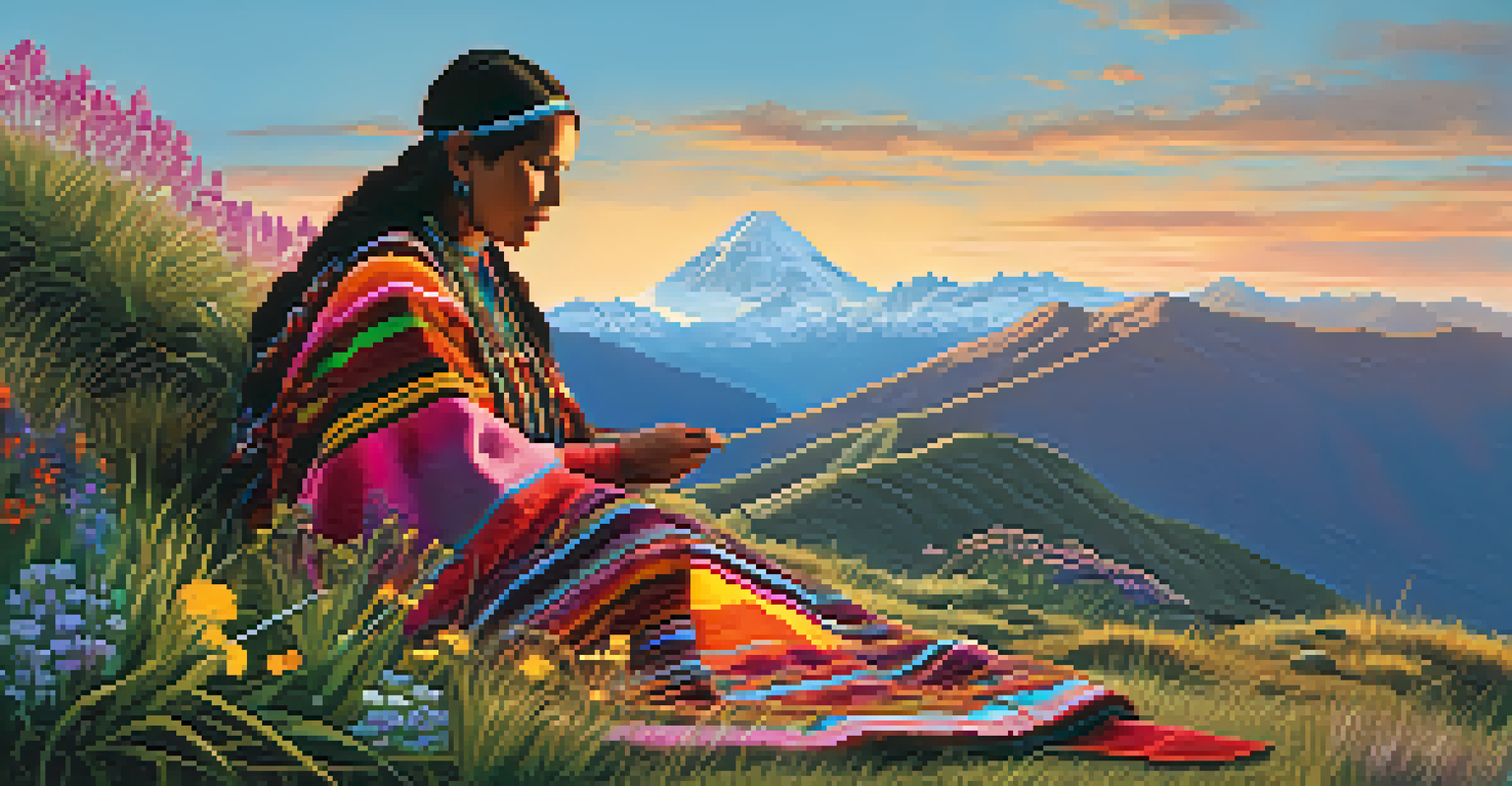The Evolution of Weaving Techniques in Peru Over Time

The Origins of Weaving in Ancient Peru
Weaving in Peru dates back thousands of years, with evidence found in archaeological sites. The earliest textile remnants, discovered in places like the Paracas Peninsula, showcase intricate designs made from cotton and wool. These materials were not only functional but also held significant cultural meaning, often depicting the social status and beliefs of the weavers.
Textiles are a reflection of a culture's identity and values.
The techniques used by these early civilizations were primitive yet effective. Simple looms were crafted from local materials, allowing artisans to create textiles that were both durable and beautiful. Notably, the Paracas culture is renowned for its elaborate burial shrouds, which highlight their advanced weaving skills.
As these ancient societies progressed, so did their weaving techniques, paving the way for a rich tapestry of styles that would emerge over subsequent centuries. This foundation laid by early weavers is a testament to the enduring legacy of textile arts in Peru.
Influence of the Inca Empire on Weaving
The Inca Empire, flourishing from the 15th century, brought a remarkable transformation to Peruvian weaving. The Incas developed a more structured approach to textile production, establishing state-run workshops that produced high-quality fabrics for both everyday use and ceremonial purposes. This shift helped standardize techniques and materials across the vast empire.

Inca textiles were characterized by their use of vibrant colors and complex patterns, often symbolizing various aspects of their culture. The incorporation of llama and alpaca wool allowed for softer, warmer garments, while their dyeing techniques produced hues that remain vivid even today. The textiles became a form of currency, showcasing the importance of weaving in their economy.
Ancient Weaving Techniques in Peru
Weaving in Peru dates back thousands of years, showcasing intricate designs and cultural significance through early techniques.
Additionally, the Inca's emphasis on textiles extended to their military and religious practices, where specific garments signified rank or ritual significance. This period solidified weaving as an integral part of Peruvian identity, influencing generations of artisans long after the empire's fall.
Post-Colonial Adaptations and Innovations
Following the Spanish conquest in the 16th century, Peruvian weaving faced significant challenges and changes. The introduction of European textiles and techniques altered traditional practices, leading to a blending of styles. Indigenous weavers began to incorporate new materials, such as silk, while still honoring their ancestral designs.
Weaving is not just a craft; it is a way of preserving stories and traditions.
This period saw the emergence of unique hybrid styles, which reflected the cultural fusion between the indigenous populace and Spanish colonizers. For instance, the use of brighter colors and intricate patterns became more prominent, giving rise to new artistic expressions. However, many traditional methods persisted, revealing the resilience of indigenous craftsmanship.
Moreover, the post-colonial era prompted a revival of interest in traditional Peruvian textiles, as artisans sought to reclaim their cultural heritage. This desire for authenticity sparked a movement to preserve ancient techniques while adapting to contemporary tastes, ensuring that the art of weaving continued to thrive.
Regional Variations in Peruvian Weaving
Peru is home to a diverse array of cultures, each contributing its own unique weaving styles. From the vibrant textiles of the Ayacucho region to the intricate patterns of the Cusco valley, these regional variations showcase the rich tapestry of Peru's cultural heritage. Each area has its distinct materials, motifs, and techniques, reflecting the local environment and traditions.
For example, the Quechua people are known for their use of vivid colors and geometric patterns, often inspired by the natural landscape. In contrast, the Aymara culture, primarily located around Lake Titicaca, produces textiles that are more subdued but equally intricate. These differences not only enhance the diversity of Peruvian weaving but also celebrate the unique identities of the various communities.
Inca Influence on Textile Production
The Inca Empire revolutionized Peruvian weaving with structured production and vibrant designs, establishing textiles as a vital economic and cultural symbol.
As globalization impacts traditional crafts, these regional styles face both challenges and opportunities. While modernization threatens to overshadow these age-old techniques, there is a growing appreciation for authentic, handwoven textiles that embody the stories and traditions of their creators.
The Role of Women in Weaving Traditions
Women have played a central role in the preservation and evolution of weaving techniques in Peru. Traditionally, weaving was often passed down from mother to daughter, with women serving as the primary custodians of this craft. Their knowledge and skills not only ensured the continuity of weaving practices but also empowered them within their communities.
In many regions, women continue to weave textiles that reflect their cultural identity, often using patterns that tell stories or symbolize their heritage. This artistry is not merely a means of creating functional items; it is a form of self-expression and a way to connect with their ancestors. The act of weaving has become a vital part of community life, fostering solidarity among women.
Today, initiatives aimed at supporting female artisans are gaining momentum, helping to elevate their work to a global audience. By promoting fair trade and sustainable practices, these programs ensure that women receive recognition and compensation for their craft, further enriching the legacy of Peruvian weaving.
Contemporary Weaving and Craft Revival
In recent years, there has been a resurgence of interest in traditional Peruvian weaving, both locally and internationally. Artisans are increasingly blending ancient techniques with modern aesthetics, creating unique pieces that appeal to contemporary consumers. This craft revival not only celebrates heritage but also ensures the sustainability of weaving practices for future generations.
Craft fairs and online platforms have provided a vital space for artisans to showcase their work, allowing them to reach a broader audience. The fusion of traditional and contemporary styles has sparked innovation, with weavers experimenting with new patterns, colors, and materials. This evolution reflects the dynamic nature of Peruvian weaving, adapting to shifting tastes while remaining rooted in tradition.
Modern Craft Revival and Innovation
Recent years have seen a resurgence in traditional weaving, blending ancient methods with contemporary styles to appeal to global audiences.
Moreover, this renewed interest has encouraged educational programs that teach younger generations the art of weaving. By fostering a sense of pride and connection to their cultural roots, these initiatives ensure that the rich history of Peruvian weaving endures, continuing to inspire and captivate.
The Future of Weaving Techniques in Peru
As we look to the future, the evolution of weaving techniques in Peru remains a vibrant tapestry woven from tradition and innovation. With the increasing demand for sustainable and ethically-produced textiles, there is a growing appreciation for the skill and artistry behind handwoven pieces. This trend presents both challenges and opportunities for artisans as they navigate the modern market.
The embrace of technology in crafting processes is also reshaping the landscape of Peruvian weaving. Digital platforms allow artisans to share their stories and connect with consumers worldwide, fostering a sense of community and understanding. However, it is crucial to balance this modernization with the preservation of traditional techniques that define Peruvian artistry.

Ultimately, the future of weaving in Peru hinges on the commitment to cultural heritage and sustainability. By supporting local artisans and recognizing the value of their craft, we can ensure that this beautiful tradition continues to flourish for generations to come.